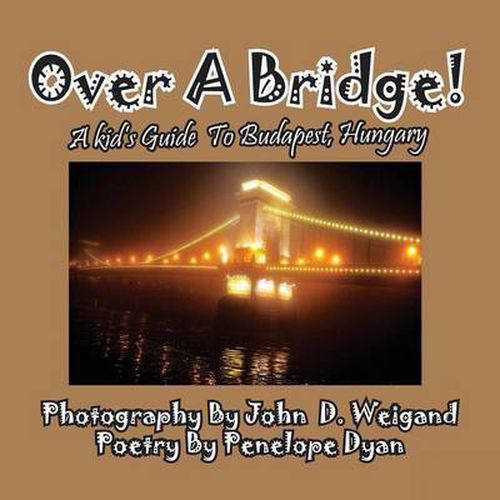Readings Newsletter
Become a Readings Member to make your shopping experience even easier.
Sign in or sign up for free!
You’re not far away from qualifying for FREE standard shipping within Australia
You’ve qualified for FREE standard shipping within Australia
The cart is loading…






This title is printed to order. This book may have been self-published. If so, we cannot guarantee the quality of the content. In the main most books will have gone through the editing process however some may not. We therefore suggest that you be aware of this before ordering this book. If in doubt check either the author or publisher’s details as we are unable to accept any returns unless they are faulty. Please contact us if you have any questions.
The name Budapest came from combining the names of two cities, Buda and Pest. Originally, there were two separate cities. Today they are connected by eight bridges crossing the Danube. The two cities became one city, a single city, in 1873. According to chronicles of the Middle Ages the name Buda came from its founder, Bleda (or Buda) the brother of Attila the Hun. There are several theories about the origin of the name Pest. One of these theories believes the word Pest, came from the Roman times, since there was a fortress Contra-Aquincum in this region called Pession. Others think the name Pest came from the Slavic word for cave , peshtera, or from the word for oven , pesht. Budapest began as a Celtic settlement that became the Roman capital of Lower Pannonia. Hungarians arrived in the 9th century. Their first settlement was pillaged by the Mongols in 1241-42.The re-established town became one of the centers of Renaissance humanist culture in the 15th century. Following the Battle of Mohacs and after nearly 150 years of Ottoman rule, the region entered an age of prosperity in the 18th and 19th centuries. Budapest became a global city after its 1837 unification. It also became the second capital of the Austro-Hungarian Empire, a great power that dissolved in 1918, after World War I. Since that time, there was revolution and more war. Budapest was a part of the USSR until its break-up and the fall of the Berlin Wall. This book contains a smattering of what you can see and do in Budapest, but not everything. Photographer John D. Weigand and award winning author, attorney and former teacher, Penelope Dyan, traveled there in winter, just before the snow; and were so entranced, they vowed someday to return in the summer and spring. The city of Budapest is considered one of the most beautiful cities in Europe, and there is plenty for a kid to do and see! Dyan and Weigand look at a place through the eyes of a young child to give them a glimpse of what they might see and to let them know, sometimes the world is not such a big place, after all!
$9.00 standard shipping within Australia
FREE standard shipping within Australia for orders over $100.00
Express & International shipping calculated at checkout
This title is printed to order. This book may have been self-published. If so, we cannot guarantee the quality of the content. In the main most books will have gone through the editing process however some may not. We therefore suggest that you be aware of this before ordering this book. If in doubt check either the author or publisher’s details as we are unable to accept any returns unless they are faulty. Please contact us if you have any questions.
The name Budapest came from combining the names of two cities, Buda and Pest. Originally, there were two separate cities. Today they are connected by eight bridges crossing the Danube. The two cities became one city, a single city, in 1873. According to chronicles of the Middle Ages the name Buda came from its founder, Bleda (or Buda) the brother of Attila the Hun. There are several theories about the origin of the name Pest. One of these theories believes the word Pest, came from the Roman times, since there was a fortress Contra-Aquincum in this region called Pession. Others think the name Pest came from the Slavic word for cave , peshtera, or from the word for oven , pesht. Budapest began as a Celtic settlement that became the Roman capital of Lower Pannonia. Hungarians arrived in the 9th century. Their first settlement was pillaged by the Mongols in 1241-42.The re-established town became one of the centers of Renaissance humanist culture in the 15th century. Following the Battle of Mohacs and after nearly 150 years of Ottoman rule, the region entered an age of prosperity in the 18th and 19th centuries. Budapest became a global city after its 1837 unification. It also became the second capital of the Austro-Hungarian Empire, a great power that dissolved in 1918, after World War I. Since that time, there was revolution and more war. Budapest was a part of the USSR until its break-up and the fall of the Berlin Wall. This book contains a smattering of what you can see and do in Budapest, but not everything. Photographer John D. Weigand and award winning author, attorney and former teacher, Penelope Dyan, traveled there in winter, just before the snow; and were so entranced, they vowed someday to return in the summer and spring. The city of Budapest is considered one of the most beautiful cities in Europe, and there is plenty for a kid to do and see! Dyan and Weigand look at a place through the eyes of a young child to give them a glimpse of what they might see and to let them know, sometimes the world is not such a big place, after all!